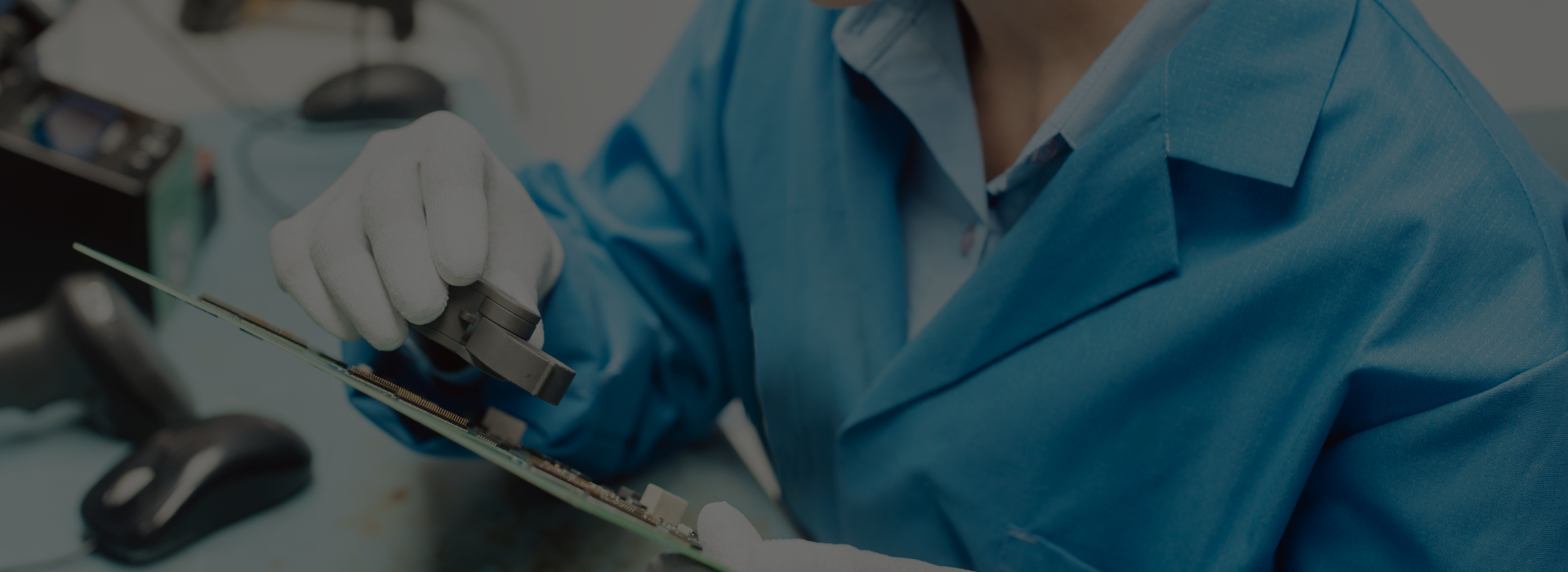Our gadgets, like smartphones and computers, work because of something called a Printed Circuit Board or PCB. Picture it as the heart of your electronic device. Making sure these circuit boards are perfect is super important, and that’s where PCB inspection comes in.
PCB inspection is a meticulous process of examining Printed Circuit Boards (PCBs) to ensure their quality, functionality, and adherence to industry standards. It involves thorough scrutiny of both bare boards and those with assembled components, aiming to identify and rectify defects that could impact the performance and reliability of electronic devices. Inspection encompasses various aspects such as dimensions, conductor spacing, hole sizes, solder joint quality, and component placement. By employing specialized equipment like Automated Optical Inspection (AOI) systems, X-ray machines, and In-Circuit Testers (ICT), manufacturers can efficiently assess PCBs and uphold the standards of excellence in electronic manufacturing.
Objectives of PCB Inspection
PCB quality control inspections center around guaranteeing optimal functionality, enhancing reliability, and promoting the longevity of electronic devices. The goal is to provide users with the best possible experience and establish lasting trust in the reliability of their electronic companions.
Functionality Assurance:
- Guarantee that electronic devices operate seamlessly, free from any glitches.
- Conduct thorough examinations of every aspect of the circuit board
- Identify and rectify potential problems to ensure optimal functionality.
Reliability:
- Ensure electronic gadgets are reliable, instilling confidence in users that their devices won’t unexpectedly fail.
- Implement rigorous inspections to eliminate factors that may compromise device reliability.
- Work diligently during PCB inspection to enhance the overall trustworthiness of electronic devices.
Longevity:
- Contribute to the extended lifespan of electronic devices.
- Inspect PCBs to verify their durability and construction for sustained performance.
- Aim for electronic devices that endure over time, providing essential services without compromising quality.
PCB Inspection Standards
A standardized approach is imperative for effective PCB inspection. These standards are not just bureaucratic checkboxes; they are essential tools for achieving reliability, functionality, and consistency in PCB inspection. They provide a common language for manufacturers, inspectors, and stakeholders, fostering a collective commitment to producing electronic devices that meet the highest quality standards. Two prominent standards that play a pivotal role are:
IPC-A-600 (Bare Board Inspection)
- This standard lays down the criteria for inspecting bare circuit boards, those without components.
- It provides detailed guidelines for assessing dimensions, conductor spacing, hole sizes, and the overall integrity of the board.
- By adhering to IPC-A-600, manufacturers can maintain consistency and excellence in the production of bare circuit boards.
IPC-A-610 (Assembled Board Inspection)
- Specifically designed for boards with assembled components, IPC-A-610 sets the benchmark for assessing solder joint quality, component placement, and overall assembly quality.
- It addresses crucial aspects such as solder paste distribution, fillet geometry, and the absence of defects like solder bridges.
- Adherence to IPC-A-610 ensures that assembled circuit boards meet industry standards and deliver high-quality performance in electronic devices.
Following these standards not only facilitates a streamlined inspection process but also enhances the interoperability of electronic components from different manufacturers.
Key Metrics for PCB Inspection
When it comes to scrutinizing Printed Circuit Boards (PCBs), certain key metrics take center stage, serving as the benchmarks for quality and reliability. These metrics vary depending on whether the inspection is for bare boards or those with assembled components.
Bare Board Inspection Metrics
Bare Board Inspection is the initial checkpoint in the journey of ensuring flawless Printed Circuit Boards (PCBs). At this crucial stage, the focus is on examining the bare boards without any assembled components. It’s akin to scrutinizing the foundation of a structure before the walls go up—a meticulous examination to catch any inherent flaws and ensure that the fundamental building blocks are in perfect order.
Dimensions and Tolerances
- Verify that the dimensions of the bare board align with the design specifications.
- Ensure that tolerances (permissible variations) are within the acceptable range.
Conductor Spacing
- Check the spacing between conductors to avoid any unintended connections or short circuits.
- Confirm that the conductor spacing adheres to the specified standards.
Hole Sizes
- Inspect the sizes of holes in the board, ensuring they match the design requirements.
- Verify proper plating to prevent connectivity issues.
Surface Finish Quality
- Examine the surface finish for any irregularities or defects that could impact performance.
- Confirm that the surface finish meets the defined quality standards.
Assembled Board Inspection Metrics
Once the components are in place, the spotlight shifts to Assembled Board Inspection. This phase delves into the intricacies of the fully populated PCB, akin to inspecting the final structure of a building to guarantee its functionality and reliability.
Solder Joint Quality
- Evaluate the quality of solder joints, considering factors like distribution, filet geometry, and overall integrity.
- Identify and rectify any issues, such as solder balls or insufficient solder, that could compromise connectivity.
Component Placement
- Check that components are correctly placed on the board according to the design.
- Ensure proper orientation of components to avoid functionality issues.
Solder Paste Distribution
- Examine the distribution of solder paste, as uneven distribution can lead to defects.
- Ensure that solder paste is applied uniformly to achieve strong and reliable solder joints.
Absence of Defects
- Scrutinize the board for common defects like solder bridges, which can cause short circuits.
- Confirm the absence of foreign materials that may impact the performance of the assembled board.
By paying close attention to these key metrics during the inspection process, manufacturers can not only meet industry standards but also produce PCBs that deliver optimal functionality and reliability in electronic devices. These metrics serve as a comprehensive checklist, guiding inspectors to ensure that every aspect of the PCB aligns with the desired quality benchmarks.
Common PCB Defect Types
Understanding common defects is essential for effective inspection. Some of the prevalent defects include:
- Solder Bridges: Unintended connections between adjacent solder joints.
- Solder Balls: Small balls of solder that can cause short circuits.
- Component Misalignment: Incorrect placement or orientation of components.
- Lifted Pads: Pads that have detached from the PCB, compromising connectivity.
- Insufficient Solder: Inadequate solder leading to weak or non-existent joints.
PCB Inspection Equipment
The efficiency of electronic product testing heavily relies on the equipment employed. These technological marvels play a pivotal role in scrutinizing both bare and assembled boards, uncovering minute details that may escape the human eye. Here’s a closer look at some of the essential PCB inspection equipment:
Automated PCB Optical Inspection (AOI) Systems
- These systems utilize advanced cameras and image recognition software to rapidly inspect PCBs for defects.
- AOI systems excel in detecting issues such as solder joint quality, component misalignment, and surface finish irregularities.
X-ray Machines
- Similar to medical X-rays, these machines provide a deeper view of the internal structure of assembled boards.
- X-ray inspection is instrumental in identifying hidden defects like solder voids and ensuring the integrity of complex component placements.
In-Circuit Testers (ICT)
- ICTs assess the electrical characteristics of a PCB, verifying the functionality of individual components and overall circuitry.
- These testers are invaluable for identifying faults in components, ensuring that the electrical pathways are sound.
Flying Probe Testers
- Flying probe testers use movable probes to perform electrical tests on the PCB without the need for dedicated test points.
- Ideal for low-volume production, these testers are versatile and can adapt to various PCB designs.
Microscopes
- High-powered microscopes, equipped with magnification capabilities, allow inspectors to closely examine the intricate details of a PCB.
- Microscopes are particularly useful in identifying defects at a microscopic level, ensuring a thorough inspection.
PCB Inspection Checklist
To streamline the product inspection process, a comprehensive checklist proves invaluable. The checklist should cover aspects such as:
- Dimensional Accuracy: Verify that the board dimensions adhere to design specifications.
- Conductor Spacing: Ensure the spacing between conductors meets the required standards.
- Hole Sizes: Confirm that holes are of the correct diameter and properly plated.
- Surface Finish: Inspect the surface finish for any anomalies or irregularities.
- Solder Joint Quality: Evaluate the solder joints for proper distribution, filet geometry, and overall quality.
- Component Placement: Check that components are correctly placed and oriented according to the design.
Frequently Asked Questions
Why is PCB inspection necessary?
- PCB inspection is crucial to ensure the functionality, reliability, and compliance of electronic devices.
What are the common defects in PCBs?
- Common defects include solder bridges, solder balls, component misalignment, lifted pads, and insufficient solder.
Which standards govern PCB inspection?
- IPC-A-600 is the standard for bare board inspection, while IPC-A-610 governs assembled board inspection.
What equipment is used for PCB inspection?
- Automated Optical Inspection (AOI) systems, X-ray machines, and In-Circuit Testers (ICT) are commonly used for PCB inspection.
How does PCB inspection contribute to product quality?
- PCB inspection ensures that electronic devices meet design specifications, adhere to industry standards, and are free from manufacturing defects.
Conclusion
Global Inspection Managing (GIM) is the ideal partner for companies seeking excellence in their product quality and reliability. Specializing in Printed Circuit Board (PCB) inspection, we bring unparalleled expertise, ensuring meticulous evaluations from dimensions to solder joint quality. Our proficiency in pre-shipment inspection minimizes defects and ensures customer satisfaction, while on-the-ground presence in manufacturing hubs enables effective quality control in China. With a commitment to seamless process integration, reliability, and tailored solutions, GIM offers companies a strategic ally for achieving and maintaining the highest industry standards.
Adhering to industry standards, employing advanced inspection equipment, and following a comprehensive quality control checklist are the cornerstones of effective PCB inspection. By embracing these practices, manufacturers not only ensure the functionality and reliability of electronic devices but also contribute to the overall safety and satisfaction of end-users. As we navigate the ever-evolving landscape of technology, the role of PCB inspection remains paramount in upholding the standards of excellence in electronic manufacturing.

